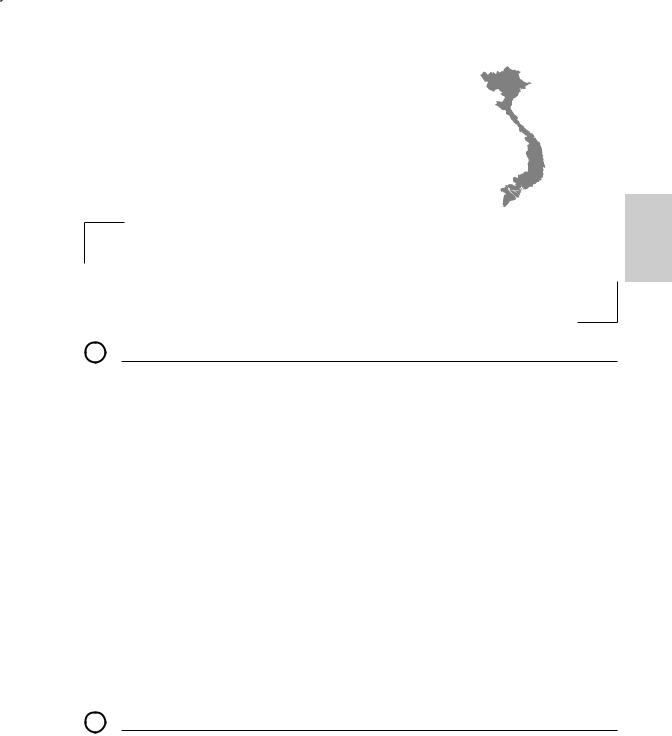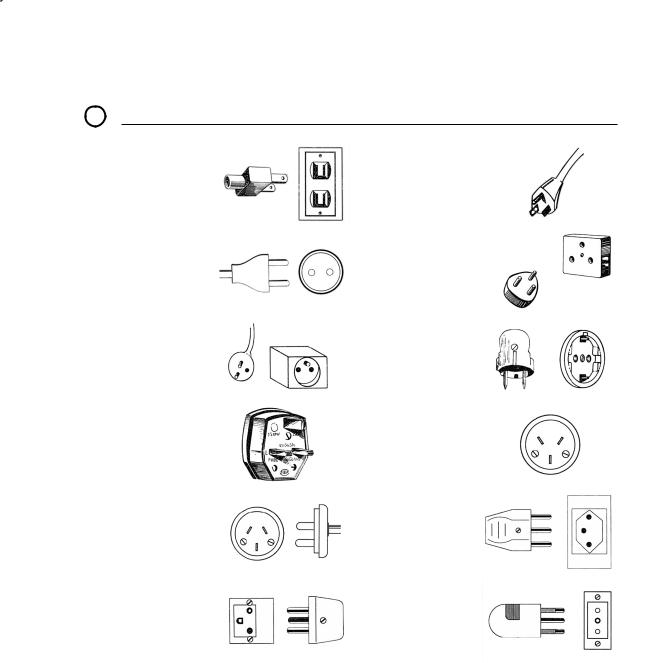
- •Contents
- •Preface
- •Introduction
- •Cultural Orientation
- •Argentina
- •Austria
- •Australia
- •Belarus
- •Belgium
- •Belize
- •Bolivia
- •Brazil
- •Canada
- •Chile
- •China
- •Hong Kong
- •Colombia
- •Costa Rica
- •Czech Republic
- •Denmark
- •Ecuador
- •Egypt
- •Finland
- •France
- •Germany
- •Greece
- •Guatemala
- •Honduras
- •Hungary
- •India
- •Indonesia
- •Ireland
- •Israel
- •Italy
- •Japan
- •Kuwait
- •Malaysia
- •Mexico
- •The Netherlands
- •New Zealand
- •Norway
- •Pakistan
- •Panama
- •Paraguay
- •Peru
- •Philippines
- •Poland
- •Portugal
- •Romania
- •Russia
- •Saudi Arabia
- •Singapore
- •South Africa
- •South Korea
- •Spain
- •Sweden
- •Switzerland
- •Taiwan
- •Thailand
- •Turkey
- •Ukraine
- •United Kingdom
- •United States
- •Uruguay
- •Venezuela
- •Vietnam
- •Index

Vietnam
Socialist Republic of Vietnam
Local long form: Cong Hoa Xa Hoi Chu Nghia Viet Nam
Local short form: Viet Nam
Cultural Note
The process of transforming from a Communist command economy to a market-oriented economy is never easy. The government’s lack of transparency and low pay to government officials is a recipe for corruption. Another problem is competition among government agencies for jurisdiction over foreign investments. At present, multiple bureaucracies may claim control over foreign-controlled business—and each of them want to impose licenses and taxes.
Vietnam
●3 What’s Your Cultural IQ?
1.Vietnam was divided into two antagonistic countries between 1956 and 1975. True or False: During this time, the south was known as “The Democratic Republic of Vietnam,” while the north chose the shorter “Republic of Vietnam.”
ANSWER: False. Reverse the names.. South Vietnam used the name Republic of Vietnam. In common with other Communist-bloc countries, North Vietnam added “Democratic” to its name (although it was nothing of the sort).
2.The traditional Vietnamese coat of arms is decorated with four animals. True or False: Three of these animals are mythological.
ANSWER: True. The coat of arms boasts a dragon, a unicorn, a phoenix, and a turtle.
3.Match the following Vietnamese terms with the comestibles they represent:
a. |
Bia Hoi |
1. |
Noodle soup |
b. |
Nuoc Mam |
2. |
Fresh beer (freshly brewed and served) |
c. |
Pho |
3. |
Rice wine |
d. |
Ruou |
4. |
Fish sauce |
ANSWERS: a. 2; b. 4; c. 1; d. 3
●3 Tips on Doing Business in Vietnam
●The official governmental policy toward business in Vietnam is doi moi (renovation). While the execution may sometimes be rocky, there is official admission that changes must be made.
571

572 Kiss, Bow, or Shake Hands
|
● |
The Communist government remains a major influence, corruption is common, and the |
|
|
|
infrastructure is still limited. However, labor costs are extremely low and the Vietnamese |
|
|
|
are anxious for outside investments. |
|
|
● |
Vietnam has a million eager, aggressive businesspeople. In addition to this motivated |
|
|
|
work force, Vietnam has a variety of natural resources. Besides exporting rice and other |
|
|
|
agricultural products, Vietnam has started exporting oil. Their recently developed oil |
|
|
|
||
Vietnam |
|
reserves are producing tens of millions of barrels. |
|
● |
In common with other Confucian cultures, age is highly respected in Vietnam. Foreign |
||
|
|||
|
|
business delegations should always include a senior member to whom the other members |
|
|
|
must defer in public. Similarly, foreigners must show great respect to the senior members |
|
|
|
of any Vietnamese organization. Older executives are viewed as more experienced, wiser, |
|
|
|
and should be held in esteem. |
●3 Country Background
History
Southeast Asia has been home to civilizations for thousands of years. China occupied the region for over 1,000 years, starting in 111 b.c. The region achieved independence from China in a.d. 939, and adopted a native dynasty of rulers. The ethnic Vietnamese were northerners who gradually moved south and eventually reached the Mekong delta.
The nation of Vietnam (as a country distinct from the rest of Southeast Asia) dates back only as far as the French colonization. The French began their conquest in 1858, and by 1885 they were in effective control of the entire country. The French allowed the Vietnamese emperors to remain on the throne, but they were subject to French orders.
By the start of the twentieth century, some French-educated Vietnamese began to agitate for independence. Ho Chi Minh, whom Vietnamese consider the father of Vietnamese independence, was one of these. Ho Chi Minh organized various groups into a nationalist front, although most anti-Communist groups refused to join.
Japan occupied Vietnam in the Second World War, demonstrating that the French could be defeated. At the end of the war, before the French could reassert power, Ho Chi Minh declared the birth of the independent Democratic Republic of Vietnam on September 2, 1945.
French forces returned and refused to acknowledge Vietnamese independence. An eightyear guerrilla war ensued. This ended with the defeat of the French and their anti-Communist Vietnamese allies at Dien Bien Phu in 1954. A peace conference convened in Geneva, Switzerland, resulting in the temporary division of Vietnam at approximately the seventeenth parallel. The Communists were given control of the north; the anti-Communists the south. The two halves of the country were intended to be reunited after a national election by July 1956.

Vietnam |
573 |
However, the anti-Communists refused to participate in the election. Consequently, the division of the country into North Vietnam and South Vietnam lasted for almost two decades.
North Vietnam, with the support of the USSR and the People’s Republic of China, began another guerrilla war. With the French unwilling to commit troops, the United States decided to support South Vietnam. U.S. military forces were initially sent into combat in 1965 by President Johnson. The level of U.S. forces in Vietnam peaked at 534,000 in 1969. Widespread opposition to the war led politicians in Washington, DC, to attempt to replace U.S. troops with South Vietnamese forces. But the Army of South Vietnam was unable to stop the Communist forces, and Saigon, the South Vietnamese capital, fell on April 30, 1975. By the end of the year, both halves of the country were united under a Communist government as the Socialist Republic of Vietnam.
After consolidating its power after reunification, the government of Vietnam felt threatened by the Khmer Rouge in neighboring Cambodia. Vietnam invaded Cambodia in December 1978. While most Western governments did not approve of the Vietnamese government, they considered the genocidal Khmer Rouge the greater evil.
In 1989, Vietnam withdrew its troops from Cambodia, and by 1991, it had forged diplomatic relations with many countries, including China and the United States. Vietnam and the United States signed a trade accord in 1991, finally allowing Vietnamese goods into the United States.
Vietnam’s national holiday is Vietnamese National Day, celebrated on the second of September. However, the most important holiday is always the three-day celebration for the lunar New Year, or Tet.
Vietnam
Type of Government
The Socialist Republic of Vietnam is a constitutional republic dominated by the Communist Party. The National Assembly is the supreme organ of the state. The president and prime minister of Vietnam are elected by the National Assembly. The president is the head of state. The prime minister can be described as head of the government, because he is charged with the day-to-day handling of government organizations.
The Vietnamese Communist Party holds a national congress every five years to formalize policies and to outline the country’s overall direction. The Party Congress also elects a Central Committee, which usually meets at least twice a year.
For current government data, check with the Embassy of Vietnam at www.vietnamem bassy-usa.org.
Language
The official language is Vietnamese. English has now replaced French as the preferred second language.
Ethnologue.com has listed a total of 103 languages in Vietnam. Only 1 of these languages is extinct: a pidgin combining French and Vietnamese known as Tay Boi.

574 |
Kiss, Bow, or Shake Hands |
Vietnam
Cultural Note
Vietnam has two large religious groups (sometimes described as cults) that are unfamiliar to outsiders. Hoa Hao is derived from Buddhism but advocates direct, simple worship without intermediaries. It was founded in 1939 by a man from the Mekong delta named Huynh Phu So. The French derided him as a“mad monk,” and the political activities of his followers caused Hoa Hao to be banned periodically.
Cao Dai is even more unusual: it is a syncretic faith that combines aspects of all the religions of Vietnam. Created in the 1920s, its leader, Ngo Minh Chieu, mixed such diverse beliefs as ancestor worship, Buddhism, Christianity, and Islam. Cao Dai has a pantheon of unusual saints, including Joan of Arc, Victor Hugo, Louis Pasteur, and Napoleon Bonaparte!
The Vietnamese View
The constitution of the Socialist Republic of Vietnam guarantees freedom of religion. The country’s diverse population follows many religious beliefs. Confucianism (which is a philosophy more than a religion) has had a great effect on Vietnamese thought and tradition. Historically, the largest and most important religion in Vietnam was Buddhism. Although the Communist government describes Buddhism as currently “in decline,” it acknowledges that 70 percent of Vietnamese are “strongly influenced” by Buddhist tradition.
Many other religions are represented in Vietnam. Also, as is common in Asia, religious beliefs often overlap. Vietnamese Catholics also may go to Buddhist temples; Vietnamese Muslims also may engage in ancestor worship. The current breakdown of religion in Vietnam is:
Buddhist—about 70 percent
Roman Catholic—about 10 percent (Catholicism entered Vietnam in the seventeenth century and was supported by the French colonials.)
Cao Dai—approximately 2 million Hoa Hao—over 1 million Protestant—less than a half-million
Islam—approximately 50,000 (Islam is concentrated among the Cham ethnic minority near the coastline in Central Vietnam.)
As you would expect, views on Vietnam vary between groups. Anti-Communists and supporters of the defeated South Vietnamese government view today’s Vietnam rather critically. Many of these Vietnamese left around the time Saigon was overrun in 1975. The so-called “Boat People” who fled after the Communist absorption of all South Vietnam in 1976 may have cynical views of both Communist governments and the West, because many Boat People were left to languish in refugee camps for years by Western governments. (For example, some spent years in camps in British-ruled Hong Kong.)
Finally, some of the many ethnic minorities of Vietnam may also dislike the Communist government. These include the Hmong, who were persecuted as allies of the United States, and Vietnam’s ethnic Chinese—a traditional merchant class who were devastated when the Communists made private trade illegal in 1978. Almost a half-million ethnic Chinese

Vietnam |
575 |
left Vietnam during that period, primarily by boat. Many were encouraged to leave by the Vietnamese government. (This mistreatment of Vietnam’s ethnic Chinese contributed to the attack on the Vietnamese border by the People’s Republic of China in 1979.)
*Know Before You Go
■
To the average business traveler in Vietnam, the greatest hazard is vehicular traffic. Traffic in Vietnam’s fast-growing cities is chaotic, with trucks, cars, motorcycles, and bicycles all competing for space. Pedestrians can be in as much danger as drivers and their passengers. Exercise caution and hire a driver rather than drive yourself.
After dark, foreigners should avoid using the less-regulated forms of transport, such as motorcycle taxis and cyclos (also known as pedicabs). Also, at any time of day, you should negotiate the fee before entering a motorcycle taxi or cyclo: they have no meters. In a taxi, insist your driver use his meter.
Violence against foreigners is very rare, in part because the penalties for harming a foreigner are draconian. A Vietnamese who killed a foreigner in 1996 was quickly found, tried, and executed.
Vietnam
●3 Cultural Orientation
Vietnam’s recent history has been highly dynamic, and to date, there has not been much detailed study of Vietnamese cultural orientations. Pending further research, the following observations can be made:
Cognitive Styles: How Vietnamese Organize and Process Information
Historically, by accepting the foreign concept of Marxism, the leaders of Vietnam became closed to outside information. Because the Communist victory took the better part of a century, unswerving dedication to Marxist ideals became a necessity. However, the Communist reunification of divided Vietnam took place during the decline of global Communism. The dissolution of Vietnam’s primary benefactor, the USSR, required the Vietnamese leadership to become more open to other, non-Communist ideals.
As a market-oriented society, Vietnam’s decision-makers and businesspeople have—of necessity—become more open to outside concepts and more analytic than associative. Nevertheless, they may place more value on relationships than obedience to abstract rules of behavior.
Negotiation Strategies: What Vietnamese Accept as Evidence
Vietnamese relate each instance to their own experience, making search for truth highly subjective. Even experienced Vietnamese businesspeople may not make decisions entirely based on objective facts.
Value Systems: The Basis for Behavior
The following three sections identify the Value Systems in the predominant culture—their methods of dividing right from wrong, good from evil, and so forth.

576 |
Kiss, Bow, or Shake Hands |
Vietnam
Locus of Decision-Making
While responsibility for decision-making rests on the shoulders of the individual, decisions are always made with the family in mind. A Vietnamese will often consider “What is best for my family?” when making a choice.
Sources of Anxiety Reduction
Vietnam’s current transition to a market-oriented economy offers exciting opportunities for its citizens, but it also causes great anxieties. There are clear winners and losers. Vietnamese laborers in inefficient, state-owned industries know that they will be among the losers.
The extended family forms the basic unit of Vietnamese society and also provides the main source of security. Ancestor worship reinforces the importance of the family as well.
Issues of Equality/Inequality
Vietnam remains a hierarchical country. Under Confucian tradition, each person has a place and knows to whom to defer. Hierarchical structures are also found in government, business, and other organizations.
The ethnic Vietnamese have traditionally looked down upon the country’s ethnic minorities. The rural minorities, such as the Montagnards (mountain people), have often reinforced Vietnamese stereotypes by trying to remain separate from mainstream Vietnamese society.
The Communist ideal includes gender equality, and women have equal rights under the law. However, Vietnam is still a male-dominated country, both in business and government. In most ethnic groups, the husband remains the titular head of the home. The aged are considered more knowledgeable than the young, and their opinions are highly respected.
●3 Business Practices
Punctuality, Appointments, and Local Time
●Punctuality is key; be on time for all business engagements.
●Being prompt is not as vital for social events, but do not be more than a half-hour late.
●In Vietnam, as in most other countries, the day is written first, then the month, then the year (e.g., December 3, 2010, is written 3.12.10).
●Prior appointments are necessary; do not try to make an impromptu office visit.
●Vietnam is seven hours ahead of Greenwich Mean Time (G.M.T. +7), or thirteen hours ahead of U.S. Eastern Standard Time (E.S.T. +13).
Negotiating
●The Vietnamese are great fans of bargaining. They dicker over the price of everything, from taxi rides to real estate. When you finally get around to talking about the price, expect them to negotiate aggressively.

Vietnam |
577 |
|
|
● |
Connections are all-important in Vietnam. You cannot do anything unless you are know |
|
|
|
|
||
|
the right (that is, powerful) people. Personal introductions are preferred, but a letter of |
|
|
|
introduction is better than nothing. |
|
|
● |
The Vietnamese need to personally trust you before they will do business with you. |
|
|
|
|
||
|
Expect to spend a substantial amount of time exchanging small talk, drinking tea, and |
|
|
|
developing a rapport. Do not consider this time wasted. |
|
|
● |
In common with other Asian cultures, the Vietnamese will often say what they believe |
Vietnam |
|
|
|||
|
foreigners want to hear. It is your job to learn to tell the difference between honest agree- |
||
|
ment and a polite-but-insincere “yes.” |
|
|
● |
High pressure and emotion have little place in business in Vietnam. Most would rather |
|
|
|
let a deal fall through than be rushed. |
Business Entertaining |
|
●Your Vietnamese host will give at least one meal in your honor. You should return the favor by hosting a meal at an international hotel or fine restaurant.
●Business meetings are often held over lunch. Dinners are usually considered social occasions, but work can be discussed—if your Vietnamese counterpart initiates the topic.
●Expect beer or spirits to be served at a Vietnamese banquet. The senior member of your party will be expected to make a short speech—or, at least, a toast.
●Karaoke has become very popular in Vietnam. It is worthwhile to prepare a song if you are asked to sing.
●If you happen to visit a Vietnamese kitchen, you will probably find it decorated with the images of three Vietnamese kitchen gods.
●Vietnam is becoming a destination for culinary travelers. The Vietnamese have learned to make food out of virtually every nonpoisonous fish, beast, and plant native to their country. However, for those who are gastronomically timid, there are other cuisines available in Vietnam. In addition to Chinese and Thai food, Vietnamese cities have restaurants serving French and American cuisine. One can spend a considerable amount of time in Vietnam eating nothing but hamburgers and pizza.
●If you are a beer aficionado, you might want to visit one of the enormous beer halls that serve Bia Hoi (fresh beer)—brewed and served the same day.
Cultural Note
As a developing country,Vietnam boasts a relatively small number of entertainment venues. After the workday, the legal forms of entertainment consist of karaoke, traditional arts performances, such as music, dance, water puppets—or drinking. While the Vietnamese are usually happy to welcome foreigners into their bars and beer gardens, keep in mind that they have a number of drinking games. You’re in trouble when a Vietnamese shouts “tram van tram,” which means “100 percent!” You are now in a race with the challenger to drain your drink! Of course, as soon as you drain that one, several more Vietnamese will undoubtedly challenge you again.

578 Kiss, Bow, or Shake Hands
|
● |
Protocol |
|
|
3 |
|
|
|
|
||
|
Greetings |
||
|
● |
The traditional greeting is a slight bow with the hands clasped together above the waist. |
|
|
|
There is no physical contact. However, the vast majority of businesspeople in Vietnam |
|
|
|
will greet you with either a slight bow or a handshake. |
|
Vietnam |
● |
It is not traditional for Vietnamese to introduce themselves, and their subordinates will |
|
|
often not introduce their boss, either. This is one reason that a personal introduction is |
|
extremely useful in Vietnam—from a person considered more-or-less an equal. |
● |
Good topics of conversation are sports, travel, food, and music. |
● |
If a Vietnamese superstition is discussed, take it seriously. There are many Vietnamese |
|
who will give it credence, and your host may be one. |
● |
Most (but not all) businesspeople have business cards. There is little formality involved |
|
in exchanging cards. |
● |
Your card will not be refused, but you might not be given one in exchange. Don’t be |
|
offended by this. |
Titles/Forms of Address
●Vietnamese names are written in this order: surname (a.k.a., family name) followed by two given names. Except in the most formal of situations, everyone will address the person by the second family name (that is, the final one in the series of three names), although this name may be preceded by an honorific.
●It is very important to use professional and governmental titles.
Gestures
●In common with other Communist states, Vietnam is a relatively puritanical country. Although brief hugs or a kiss on the cheek are acceptable between friends, extended public contact between the sexes is frowned upon.
●In general, do not touch your Vietnamese associates at work. Allow for more physical distance between you than is normal in the West.
●The foot is considered unclean by many Vietnamese. Do not move anything with your feet, and do not touch anything (except the ground) with your feet.
●Do not show the soles of your feet (or shoes). This restriction determines how one sits: you can cross your legs at the knee but not with one ankle on your knee. Also, do not prop your feet on anything not intended for feet, such as a desk.
●Among Vietnamese Muslims, the left hand is considered unclean. Favor your right hand over your left when you are among them.

Vietnam |
579 |
●As in much of the world, to beckon someone you hold your hand out, palm downward, and make a scooping motion with the fingers. Beckoning someone with the palm up and wagging one finger—as in North America—can be construed as an insult.
Gifts
● |
Gifts are part of doing business in Vietnam. Come prepared with a gift for each par- |
|
|
||
|
ticipant on your first meeting. These gifts need not be expensive: pens, small electronics, |
Vietnam |
|
and illustrated books of your home country are all acceptable gifts. |
|
|
|
|
● |
A more expensive gift is expected to commemorate the successful conclusion of a busi- |
|
|
ness deal or your return to your home country. |
|
● |
Gifts should be carefully wrapped. Currently, the old tradition of not opening a wrapped |
|
|
gift in the presence of the giver is fading away. Some Vietnamese will put a wrapped gift |
|
|
aside to open later; some will open it immediately. You should follow their suggestion as |
|
|
to when you open a gift. |
|
● |
Avoid using wrapping paper that is primarily white or black. Both of these colors are |
|
|
associated with death and mourning. |
|
● |
Always bring something when invited to a house. Wine, candy, or flowers are the tradi- |
|
|
tional choices. |
|
Dress
●Dress in Vietnam is fairly casual, although clothing should cover most of the body (despite the tropical heat).
●While Communist governments are often quite puritanical, the current government of Vietnam restored national beauty contests in 1992. The classic Vietnamese four-flap dress worn by everyone from schoolgirls to beauty pageant contestants is known as the ao dai. Traditionally, the ao dai was only worn once a year, during the Tet Festival.
Cultural Note
Modesty is a characteristic of Vietnamese culture. Consequently, bragging and hype are alien to them, and they are apt to respond badly to pompous behavior.

Appendix A
Titles and Forms of Address
There are many naming conventions within Kiss, Bow, or Shake Hands: single names, compound names, patronymics, names read right to left or left to right, honorifics, etc. For efficiency’s sake, if multiple countries utilize the same naming customs, we have tried to consolidate them here. Some of this data may be repeated in certain chapters.
Titles and Forms of Address for most Spanish-Speaking Countries (excluding Argentina)
●Historically, many parents followed a Christian tradition and gave their children compound names at their baptism. For example: Juan Antonio, or Maria Rosa. The first names would usually include a saint’s name, or a name of a relative or godparent—or both.
●At a confirmation ceremony, a middle name was often added, which might be derived from the person’s “Saint’s Day” (e.g., October 18 is the Feast of St. Luke, so a child born on that day might receive the name Luke, or Lucia). Confirmation names are not often included in business or social interactions.
●First (and possibly, middle names) would then be followed by compound family names (or surnames): one from the father, which would be listed first, followed by one from the mother. The father’s surname was commonly used when addressing someone—e.g., Señor José Antonio Martínez de García would be addressed as Señor Martínez, and Señorita Pilar María Nuñez de Cela would be addressed as Señorita Nuñez.
If the two people in the above example married, the woman would traditionally add her husband’s surname and be known by that: Señora Pilar María Nuñez Cela de Martínez. Most people would refer to her as Señora de Martínez or, less formally, Señora Martínez.
●As women become increasingly independent, they may retain their maiden names, or use any combination thereof.
●As a general rule, use only one surname when speaking to a person, but use both surnames when writing.
●Additionally, it is important to address individuals by any titles they may have, followed by their surnames. For example, teachers may prefer the title Profesor, and engineers may go by Ingeniero.
●Don and Doña are additional titles of respect
●In Spain, the use of the familiar (tú) and formal (Usted) forms of address are different from their usage in Latin America. For example, Spaniards may speak to domestic employees in the formal (Usted) manner; they feel this confers dignity and shows respect for the person.
580

Appendix A: Titles and Forms of Address |
581 |
Chinese Naming Conventions
●Chinese names are listed in a different order from Western names. Traditionally, each person received three characters from the Chinese language. The first was the family name (from the father), then a middle name (which used to be called a generational name—one for all the brothers and another for all the sisters in a family), and finally a given name—in that order. Historically, generational names could have been planned out by a family’s ancestors and served a great purpose across the generations.
●After the Cultural Revolution, generational names became less common and were supplanted by individual middle names. For example, in 2005, the President of the People’s Republic of China and General Secretary of the Communist Party of China, President Hu Jintao had the family name of Hu, a middle name of Jin, and a given name of Tao. (His name could also be rendered Hu Chin-t’ao.)
●Chinese wives do not generally take their husband’s surnames but instead maintain their maiden names. Although westerners commonly address a married woman as “Mrs.” plus her husband’s family name, it is more appropriate to call her “Madam” plus her maiden family name. For example, Liu Yongqing (female) is married to Hu Jintao (male). While westerners would probably call her Mrs. Hu, she is properly addressed as Madam Liu.
●For the sake of Western conventions, Chinese women sometimes use their husbands’ last names.
●Similarly, many Chinese adopt English first names so that English speakers can have familiarsounding names to identify them. Thus, Chang Wu Jiang may call himself Mr. Tony Chang. Others use their initials (Mr. T. J. Chang), which indicates that Chang is his surname.
●Another way that Chinese businesspeople may clarify their surnames is by underlining or capitalizing them in written correspondence.
●Chinese names can be rendered different ways in English, so do not be surprised by variations. Chinese may have two names but more often have three names, and the most common variant is whether or not to hyphenate the final two names. For example, the first chief executive of Hong Kong was Tung Chee Hwa. His name could also be rendered Tung Chee-hwa, or even Tung Cheehwa. (As with most Chinese, his surname is listed first, so he would be referred to as “Mr. Tung.”)
●If many Chinese seem to have similar names, it is because there are only about 400 different surnames in China! However, when these surnames are transcribed into English, there are several possible variations. For example, Wong, Wang, and Huang are all English versions of the same Chinese clan name.
●Most people you meet should be addressed with a title and their name. If a person does not have a professional title (President, Engineer, Doctor), simply use “Mr.” or “Madam,” “Mrs.,” or “Miss,” plus the name.

582 |
Kiss, Bow, or Shake Hands |
●The Chinese are very sensitive to status and titles, so you should use official titles such as “General,” “Committee Member,” or “Bureau Chief” when possible. Never call anyone “Comrade” unless you are a Communist also.
Arabic Naming Conventions
●Muslim names are usually derived from Arabic. Translating from Arabic to other alphabets is not an exact science. Arabic names may be spelled several different ways in English. For example, the founder of the Kingdom of Saudi Arabia was King Abdul-Aziz Al-Saud. However, his name is also rendered in English as King Abd-al-Aziz Al Saud. History books tend to render his name as King Ibn Saud.
●Arabic naming traditions are used in many Islamic countries (e.g., Indonesia). In general, names are written in the same order as English names: title, given name, middle name (often a patronymic), and surname (family name). In 2005, the new ruler of Saudi Arabia was King Abdullah Bin-Abd-al-Aziz al Saud; his title was “King,” his given name was Abdullah, bin Abd-al-Aziz is a patronymic meaning “son of Abd-Aziz,” and al-Saud was his family name. (King Abdullah succeeded the late King Fahd in August of 2005.)
●Many Arab names have specific meanings (e.g., Amal means “Hope”), or they are from the Bible (Ibrahiim means “Abraham”), or they are based upon the name of God in Arabic. Abd or Abdul are not complete names in themselves; they simply mean “servant of.” King Abdul-al-Aziz can be translated as “Servant of the Almighty.”
●The term bin (sometimes spelled ibn) literally means “from” in Arabic, so it is not immediately apparent whether a name like bin Mubarak indicates “son of Mubarak” or “from the town of Mubarak.” However, most Saudis use it as a patronymic.
●If an Arab’s grandfather is (or was) a famous person, he sometimes adds his grandfather’s name. Thus, Dr. Mahmoud bin Sultan bin Hamad Al Muqrin is “Dr. Mahmoud, son of Sultan, grandson of Hamad, of the House (family) of Muqrin.”
●Westerners frequently mistake bin for the name Ben, short for Benjamin. Obviously, bin has no meaning by itself, and one cannot address a Saudi as bin.
●The female version of bin is bint. Thus, Princess Fatima bint Ibrahim al-Saud is Princess “Fatima, daughter of Ibrahim, of the house of Saud.”
●Arabic women generally do not change their names after they marry.
●Another common naming convention is a given name first, then the father’s given name second, followed by the family name.
●Most Saudis should be addressed by title and given name (e.g., Prince Khalil), just as you would address a member of the British aristocracy (e.g., Sir John). They can also be addressed as “Your Excellency.” In writing, use their full name.
●In Saudi Arabia, the title “Sheikh” (pronounced “shake”) is used by any important leader well versed in the Koran, or an individual worthy of great respect; it does not designate membership in the royal family.

Appendix A: Titles and Forms of Address |
583 |
●A Muslim male who has completed his pilgrimage to Mecca is addressed as Haji. A woman who has done so would be addressed as Hajjah. Note that these titles are not automatically conferred on spouses; they must be individually earned by making the pilgrimage. However, when in doubt, err on the side of generosity. It is better to give a superfluous title than to omit one.
Indian Naming Conventions
●It is important to note that India’s naming conventions are changing. For example, the southern region of India seems to be gradually moving toward the naming customs of the north, and professional females are starting to keep their maiden names.
●Titles are highly valued by Indians. Always use professional titles, such as “Professor” and “Doctor.” Do not address someone by his or her first name unless you are asked to do so, or you are close friends; use “Mr.,” “Mrs.,” or “Miss.” (In Hindi, “Mr.” is Shri and “Mrs.” is Shrimati.)
●Status is determined by age, university degrees, caste, and profession.
●Hindus in the Northern region of India generally have a given name, a middle name, and a family name—written in that order. Female siblings may share a middle name, as may male siblings.
●Because one’s name can indicate a caste, Northern Indian families sometimes opt to change their surnames.
●In the southern region, naming conventions differ. Traditionally, Hindus did not have family surnames. A Hindu Indian male may have used the initial of his father’s name first, or the town he came from, followed by his own personal name. For example, V. Thiruselvan is “Thiruselvan, son of ‘V.’” For legal purposes, both names would be written out with an s/o (for “son of”) between the names: Thiruselvan s/o Vijay. In either case, he would be known as Mr. Thiruselvan. However, long Indian names are often shortened. He may prefer to be called either Mr. Thiru or Mr. Selvan.
●Hindu female names follow the same pattern: father’s initial plus personal name. When fully written out, d/o (for “daughter of”) is used instead of s/o. When an Indian woman married, she usually ceased to use her father’s initial; instead, she followed her personal name with her husband’s name. For instance, when S. Kamala (female) married V. Thiru (male), she might go by Mrs. Kamala Thiru.
●Some Indians will use Western-style surnames. Christian Indians may have biblical surnames like Abraham or Jacob. Indians from the former Portuguese colony of Goa may have surnames of Portuguese origin, such as Rozario or DeSilva. Such a person could be addressed as Dr. Jacob or Mr. DeSilva.
●Indian Sikhs generally have a given name followed by either Singh (for men) or Kaur (for women). Always address them by a title and first name. While Singh literally means “lion,” to refer to a Sikh male as Mr. Singh may be as meaningless as saying “Mr. Man” in English.
Further data on naming conventions can be found on our Web site, www.kissboworshake hands.com, or in Merriam Webster’s Guide to International Business Communications.

Appendix B
Contacts and Resources
Because of the dynamic nature of travel warnings, customs requirements, and so on, we have selected several large Web sites that provide helpful data for international travelers. While every country has its own respective requirements, these U.S. Web sites are a reasonable start for international business contacts, travel advisories, medical information, passports, etc.
Government Sites
Contact your country’s embassy when you travel, as it can prove helpful in emergency situations. Many embassies now allow registration of your information online.
Embassies can arrange appointments with local business and government officials; provide counsel on local trade regulations, laws, and customs; and identify importers, buyers, agents, etc. They may also provide economic, political, technological, and labor data. There are many lists of embassies on the Web, such as http://usembassy.state.gov. Other helpful government sites include:
www.state.gov/travel
Provides:
Travel warnings, consular information sheets, and public announcements Passports and visas for U.S. citizens
Country background notes
Foreign consular offices in the United States Key officers at U.S. foreign service posts
www.customs.ustreas.gov
Produces a database that can be queried by topic (e.g., travel requirements, importing procedures, etc.), or an individual’s status (e.g., importer, traveler, carrier, etc.)
www.cia.gov
The U.S. Central Intelligence Agency produces several useful documents, including:
The World Factbook (at www.cia.gov/cia/publications/factbook)
The Chiefs of State and Cabinet Members of Foreign Governments (www.cia.gov/cia/ publications/chiefs/index.html). This directory is updated weekly and includes many governments of the world.
Corruption and Bribery
www.transparency.org
|
Transparency International, a worldwide nongovernmental organization, reports on cor- |
|
ruption and bribery around the world. They issue an annual “Corruption Perceptions |
|
Index,” which relates to perceptions of the degree of corruption as seen by businesspeople, |
584 |
academics, and risk analysts. In the “2005 Corruption Perceptions Index,” the 5 least |
|

Appendix B: Contacts and Resources |
585 |
corrupt countries out of 158 were Iceland (number 1), Finland, New Zealand, Denmark, and Singapore. The 5 most highly corrupt were Haiti, Myanmar, Turkmenistan, Bangladesh, and Chad (number 158).
Foreign Language Learning
Whether you are traveling for business or social purposes, learning a foreign language can tremendously increase your success and personal satisfaction. Research has also shown that learning a second language improves students’ analytic capacities. Of course, the ability to communicate in another language gives executives a huge advantage in the global market. Even a few words of greeting can make an enormous difference. There are scores of language and translation resources on the Web. On our Web site www.kissboworshakehands.com we link to viable options for foreign language programs and translation systems. As a start, try:
www.bbc.co.uk/languages
The British Broadcasting System’s excellent Web site
Medical Information
www.cdc.gov/travel
The Centers for Disease Control provides an abundance of medical resources for international travelers. It includes everything from health information and vaccinations required for specific destinations, to advice on traveling with children and pets.
Of course, you will want to be thoroughly prepared for your trip, so schedule physical and dental examinations well before leaving. Remember that some vaccinations must be given over a period of time. Also take current medical documentation with you, and list any chronic conditions and current prescription drugs (including dosages). In order to avoid problems at customs, carry all medications in their original containers. Also, take an extra set of glasses, contacts, or prescriptions. In your bags, include the name, address, and phone number of someone to be contacted in case of an emergency.
Prepare a basic medical travel kit, which might include aspirin, a topical antibiotic, bandages, a disinfectant, 0.5 percent hydrocortisone cream (for bites or sunburn), sunblock, a thermometer, and diarrhea medication. Pack the kit in your carry-on luggage.
Also confirm that you have sufficient travel medical insurance. There are two main types of travel insurance: 1) policies that make direct payments for medical care and provide assistance, and 2) policies that reimburse you for emergency expenses. (With the latter option, you might have to pay the doctor or hospital immediately—in local currency—and file a claim once you return home.)
While we do not endorse any specific organizations, the Bureau of Consular Affairs maintains an extensive list of Travel Insurance Companies, as well as Air Ambulance, MedEvac companies, and Executive Medical Services. A list of these firms is available at:
http://travel.state.gov/travel/tips/health/health_1185.html

Appendix C
Holidays
Every country in the world celebrates holidays, and little or no work is conducted during these celebrations. However, holidays are always subject to change. Governments frequently add, delete, or move certain official holidays. Furthermore, the dates for many holidays do not fall on the same day in the Western (Gregorian) calendar each year. This may be because they are dated using a calendar that does not correspond to the Western calendar (for example, the Arabic Hijra calendar is lunar and is only 354 days long).
Some cultures use lunisolar calendars (for instance, the Hebrew and Chinese calendars—although these two are not similar in other aspects), and some have both the aspects of solar and lunisolar calendars (for example, the Hindu calendar).
Actually, there are over twenty calendars in use around the world! Indonesia is a good example of one country that uses multiple calendars. They include the Gregorian calendar, one which is similar to the Islamic calendar, a calendar used primarily in Java, and several others. In Java, when the fifth day of a month coincides on all the calendars, various celebrations take place (businesses are opened, babies are named, etc.). This is because five is an auspicious number—there are five sacred mountains, five elements, and so forth.
Some holidays are purposefully consecutive, like “Golden Week” in Japan. It allows for Japanese workers to enjoy extended vacations and observe some important holidays together.
The work week may be different in various cultures as well. For example, in the Muslim world, the Sabbath is celebrated on Friday. Some Islamic nations have their “weekend” on Thursday and Friday, so their work week runs Saturday through Wednesday.
Whatever the calendar or work week in use, the only way to be sure your business trip is not interrupted by official or local holidays is to contact reliable, up-to-date sources before your trip. Consult with the country’s embassy, call your associates at your destination, or reference our World Holiday Guide at:
www.kissboworshakehands.com
One additional note:
You may see the traditional terms b.c. (before Christ) and a.d. (anno Domini, “the year of the Lord”) being used interchangeably or replaced with the terms b.c.e. (before the Common Era) and c.e. (Common Era). The new notation “Common” refers to the most common calendar—the Gregorian, or Western Calendar.
586

Appendix D
International Electrical Adaptors
This data is excerpted from a publication of the U.S. Department of Commerce.
The electricity used in much of the world (220–250 volts) is a different voltage from that used in North America (110–125 volts). Electrical appliances designed for North America may need converters to “step down” this higher voltage to the level required to operate. Some appliances cannot be converted for use elsewhere because they require sixty cycles per second (again, found primarily in North America), or they may have other requirements.
Electrical wall sockets found around the world are also likely to differ in shape from the sockets used in North America. Electrical adaptor plugs are available to slip over the plugs of North American appliances for use in such sockets (see the following charts for graphics of Plugs in Commercial Use, and for the Type of Plug by Country).
|
|
Type of Plug by Country |
|
|
||
Country Plug |
Type |
Country Plug |
|
Type |
Country Plug |
Type |
Afghanistan |
D |
Canary Islands |
|
C, E |
France |
E |
Albania |
C |
Cape Verde, Rep. of |
C, F |
Gabon |
D, E |
|
Algeria |
C, F |
Cayman Islands |
|
A, B |
Gambia, The |
G |
Angola |
C |
Central African Republic |
C, E |
Germany, Fed. Rep. of |
F |
|
Argentina |
C, I |
Chad |
|
E |
Ghana |
D, G |
Australia |
I |
Chile |
|
C, F, L |
Gibraltar |
C, G |
Austria |
C |
China, Peoples Rep. of |
C, D, G, H |
Greece |
C, F |
|
Bahamas |
A, B |
Colombia |
|
A, B |
Greenland |
C, K |
Bahrain |
G |
Congo, Dem. Rep of |
|
Grenada |
G |
|
Bangladesh |
A, C, D |
(form. Zaire) |
|
E |
Guatemala |
A, B, G, H, I |
Barbados |
A, B, F, H |
Congo, Peoples Rep. of |
C, E |
Guinea |
C, F, K |
|
Belarus |
C |
Costa Rica |
|
A, B |
Guinea-Bissau |
C |
Belgium |
A, C, E |
Cyprus |
|
G |
Guyana |
A, H |
Belize |
A, B, H |
Czech Republic |
|
E |
Haiti |
A, B, H |
Benin |
D |
Denmark |
|
C, K |
Honduras |
A |
Bermuda |
A, B |
Djibouti, Rep. of |
|
C, E |
Hong Kong |
H |
Bolivia |
A, C |
Dominican Republic |
A |
Hungary |
C, F |
|
Botswana |
C, D, H |
Ecuador |
|
A, B, C, D |
Iceland |
B |
Brazil |
A, B, C |
Egypt |
|
C |
India |
C, D, G |
Brunei |
G |
El Salvador |
A, B, C, D, E, F, G, I, J, L |
Indonesia |
C, E, F |
|
Bulgaria |
F |
England |
|
A, C, H |
Ireland |
G |
Burkina Faso |
B, E |
Equatorial Guinea |
C, E |
Israel |
C, H |
|
Burma |
C, D, F |
Eritrea |
|
C |
Italy |
L |
Burundi |
C, E |
Ethiopia |
|
C |
Ivory Coast |
C, E |
Cameroon |
C, E |
Fiji |
|
I |
Jamaica |
A, B, C, D |
Canada |
B |
Finland |
|
C, F |
Japan |
A, B, I |
587

588 |
|
|
|
Kiss, Bow, or Shake Hands |
||
Country Plug |
Type |
Country Plug |
Type |
Country Plug |
|
Type |
Jordan |
C, F, G, L |
Nigeria |
C, D, H |
Sudan |
|
C, D |
Kazakstan |
C, G, H |
Northern Ireland |
A, C, H |
Suriname |
|
C, F |
Kenya |
G |
Norway |
C, F |
Swaziland |
|
D |
Korea |
C |
Oman |
H |
Sweden |
|
C, F |
Kuwait |
C, G |
Pakistan |
B, C, D |
Switzerland |
|
C, E, J |
Laos |
A, B, C, E, F |
Palau |
A, B |
Syria |
|
C |
Lebanon |
A, B, C, D, G |
Panama |
A, B, I |
Tajikistan |
|
C, I |
Lesotho |
D |
Paraguay |
C |
Tahiti |
|
A |
Liberia |
A, B |
Peru |
A, C |
Taiwan |
|
A, B |
Luxembourg |
F |
Philippines |
A, B, C |
Tanzania |
|
D, G |
Macedonia. |
C, F |
Poland |
C, E |
Thailand |
A, B, C, D, E, G, J, K |
|
Madagascar |
C, D, E, J, K |
Portugal |
C, F |
Togo |
|
C |
Malawi |
G |
Qatar |
D, G |
Trinidad and Tobago |
|
A, B |
Malaysia |
G |
Romania |
C, F |
Tunisia |
|
C, E |
Mali, Rep. of |
C, E |
Russia |
C |
Turkey |
|
C, F |
Malta |
G |
Rwanda |
C, J |
Turkmenistan |
|
B, F |
Mauritania |
C |
Saudi Arabia |
A, B, G |
Uganda |
|
G |
Mauritius |
G |
Scotland |
A, C, H |
Ukraine |
|
C |
Mexico |
A, B |
Senegal |
C, D, E, K |
United Arab Emirates |
C, D, G |
|
Monaco |
C, D, E, F |
Serbia-Montenegro |
F |
Uruguay |
|
C, F, I, L |
Morocco |
C, E |
Seychelles |
D |
Uzbekistan |
|
C, I |
Mozambique |
C, D, F |
Sierra Leone |
D, G |
Venezuela |
|
A, B, H |
Namibia |
C |
Singapore |
B, H |
Wales |
|
A, C, H |
Nepal |
C, D |
Slovak Republic |
E |
Western Samoa |
|
H |
Netherlands |
F |
Somalia |
C |
Yemen, Rep. of |
|
A, D, G |
New Zealand |
H |
South Africa |
D |
Zambia |
|
C, D, G |
Nicaragua |
A |
Spain |
C, F |
Zimbabwe |
|
D, G |
Niger |
A, C, E |
Sri Lanka |
D |
|
|
|

Appendix D: International Electrical Adaptors |
589 |
●3 plugs In CommerCIal use
Type A |
Type B |
Flat blade attachment plug |
Flat blades with round |
|
grounding pin |
|
|
Type C |
Type D |
Round pin attachment plug |
Round pins with ground |
|
|
Type E |
Type F |
Round pin plug and |
"Schuko" plug and |
receptacle with male |
receptacle with side |
grounding pin |
grounding contacts |
|
|
Type G |
Type H |
Rectangular blade plug |
Oblique flat blades with |
|
ground |
|
|
Type I |
Type J |
Opblique flat blade with |
Round pins with ground |
ground |
|
|
|
Type K |
Type L |
Round pins with ground |
Round pins with ground |
|
|
